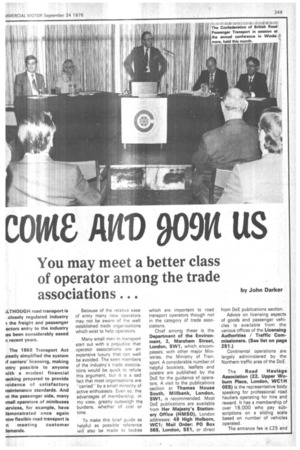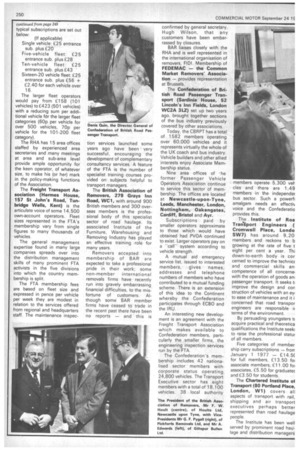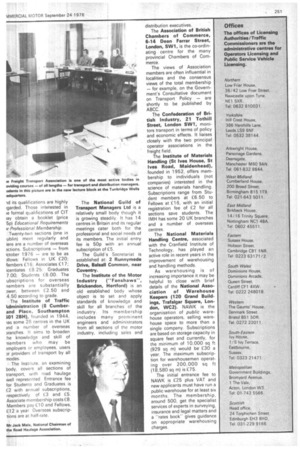You may meet a better class of operator among the trade
Page 251

Page 252

Page 253

If you've noticed an error in this article please click here to report it so we can fix it.
associations . . by John Darker
LLTHOUGH road transport is closely regulated industry • the freight and passenger ectors entry to the industry las been considerably eased n recent years.
The 19613 Transport Act Featly simplified the system rf carriers' licensing, making sntry possible to anyone rvith a modest financial sacking prepared to provide svidence of satisfactory naintenance standards. And )n the passenger side, many ;mall operators of minibuses services, for example, have lemonstrated once again tow flexible road transport is n meeting customer lemands. Because of the relative ease of entry many new operators may not be aware of the well established trade organisations which exist to help operators.
Many small men in transport start out with a prejudice that operator associations are an expensive luxury that can well be avoided. The keen members of the industry's trade associations would be quick to refute this argument, but it is a sad fact that most organisations are -carriedby a small minority of active enthusiasts. Even so, the advantages of membership, in my view, greatly outweigh the burdens, whether of cost or time.
To make this brief guide as helpful as possible reference will also be made to bodies which are important to road transport operators though not in the category of trade associations Chief among these is the Department of the Environment, 2, Marsham Street, London, SW1, which encompasses, with other major Ministries, the Ministry of Transport. A considerable number of helpful booklets, leaflets and posters are published by the DoE for the guidance of operators. A visit to the publications section at Thames House South, Millbank, London, SW1, is recommended. Most DoE publications are available from Her Majesty's Stationery Office (HMSO), London addresses: 49 High Holborn, WC1; Mail Order: PO Box 569, London, SE1, or direct from DoE publications section.
Advice on licensing aspects of goods and passenger vehicles is available from the various offices of the Licensing Authorities / Traffic Commissioners. (See list on page 251.) Continental operations are largely administered by the Northern traffic area of the DoE.
The Road Haulage Association (22, Upper Woburn Place, London, WC1H OES) is the representative body speaking for professional road hauliers operating for hire and reward. It has a membership of over 16,000 who pay subscriptions on a sliding scale based on number of vehicles operated.
The entrance fee is ±.225 and Single vehicle: £25 entrance sub. plus £.20 Five-vehicle fleet: £25 entrance sub. plus £28 Ten-vehicle fleet: E25 entrance sub. plus £43 Sixteen-20 vehicle fleet: E25 entrance sub. plus £56 + £2.40 for each vehicle over 16.
The larger fleet operators would pay from £158 (101 vehicles) to E423 (501 vehicles) with a reducing sum per additional vehicle for the larger fleet categories (60p per vehicle for over 500 vehicles, 70p per vehicle for the 101-200 fleet category).
The RHA has 15 area offices staffed by experienced area secretaries and many meetings at area and sub-area level provide ample opportunity for the keen operator, of whatever size, to make his (or her) mark in the policy-making functions of the Association.
The Freight Transport Association (Hermes House, 157 St John's Road, Tunbridge Wells, Kent) is the articulate voice of some 14,500 own-account operators. Fleet sizes represented in the FTA's membership vary from single figures to many thousands of vehicles.
The general management expertise found in many large companies spreads over into the distribution management skills of many prominent FTA activists in the five divisions into which the country membership is split.
The FTA membership fees are based on fleet size and expressed in pence per vehicle per week they are modest in relation to the services offered from regional and headquarters staff. The maintenance inspec tion services launched some years ago have been very successful, encouraging the development of complementary consultancy services. A feature of the FTA is the number of specialist training courses provided on subjects helpful to transport managers.
The British Association of Removers, 279 Grays Inn Road, WC1, with around 900 British members and 300 overseas members is the professional body of this specialist sector of road haulage. Its associated Institute of the Furniture, Warehousing and Removing Industry has played an effective training role for many years.
Removers accepted into membership of BAR are expected to take a professional pride in their work; some
non-member international removals firms have recently run into gravely embarrassing. financial difficulties, to the misfortune of customers. Although some BAR member firms have ceased to trade in the recent past there have been no reports — and this is
confirmed by general secretary, Hugh Wilson, that any customers have been embarrassed by closures.
BAR liaises closely with the RHA and is well represented in the international organisation of removers, FIDI. Membership of FEDEMAC — the Common Market Removers' Association — provides representation at Brussels.
The Confederation of British Road Passenger Transport (Sardinia House, 52 Lincoln's Inn Fields, London WC2A 312) set up two years ago, brought together sections of the bus industry previously covered by other associations.
Today, the CBRPT has a total of 1582 members operating over 60,000 vehicles and it represents virtually the whole of the UK coach and bus industry. Vehicle builders and other allied interests enjoy Associate Membership status.
Nine area offices of • he former Passenger Vehicle Operators Association continue to service this sector of membership. The offices are located at Newcastle-upon-Tyne, Leeds, Manchester, London, Nottingham, Oakengates, Cardiff, Bristol and Ayr.
Subscriptions paid by smaller operators approximate to those which would have obtained had PVOA continued to exist. Larger operators pay on a "call" system according to vehicle strength.
A mutual aid emergency service list, issued to interested members, gives names, addresses and telephone numbers of members who have contributed to a mutual funding scheme. There is an extension of this idea to the Continent whereby the Confederation participates through ECBO and the IRU.
An interesting new development is an agreement with the Freight Transport Association which makes available to Confederation members, particularly the smaller firms, the engineering inspection services run by the FTA.
The Confederation's membership includes 42 nationalised sector members with corporate status operating 24,800 vehicles. The Transport Executive sector has eight members with a total of 18,100 vehicles. 38 local authority
The President of the British Association of Removers, Mr F. W. Hoult (centre), of Hoults Ltd, Newcastle upon Tyne, with VicePresidents Mr G. F. Pygall (right), of Pickfords Removals Ltd, and Mr A. Edwards (left), of Giltspur Bullen Ltd.
members operate 5,300 vetcies and there are 1,49
members in the independei bus sector. Such a powert amalgam needs an effecti‘ voice and the Confederatic provides this.
The Institute of Roa Tranlport Engineers ( Cromwell Place, Londo SW7) has around 9,20 members and reckons to b growing at the rate of five t eight per cent a year. Thi down-to-earth body is cor
cerned to improve the technici• and commercial skills an competence of all concerne, with the operation of goods an passenger transport. It seeks t, improve the design and con struction of vehicles with an ey, to ease of maintenance and it i concerned that road transpor engineers are responsible ii terms of the environment.
By persuading youngsters ti acquire practical and theoretica qualifications the Institute seek: to raise the professional statu: of all members.
Five categories of member ship carry subscriptions -frorr January 1 1977 — £14.5( for full members, £13.50 fol associate members, £11.00 to: associates, £5.50 for graduate5. and E3.50 for students.
The Chartered Institute al Transport (80 Portland Place, London, IN1) covers all aspects of transport with rail, shipping and air transport executives perhaps better represented than road haulage people.
The Institute has been well served by prominent road haulage and distribution managers
id its qualifications are highly ?garded. Those interested in le formal qualifications of CIT lay obtain a booklet (price 5p) Educational Requirements )r Professional Membership.
Twenty-two sections (one in 'ublin) meet regularly and lere are a number of overseas actions. Subscriptions — from lctober 1976 — are to be as )Ilows: Fellows in UK £20; lernbers £16, Associates £17; icentiates £8.25, Graduates 7.00; Students E6.00. The ubscriptions for overseas nembers re substantially Dwer, between £2.50 and .4.50 according to grade.
The Institute of Traffic kdministration (8 Cumberand Place, Southampton 301 2BH), founded in 1944, las some 28 centres in the UK 3nd a number of overseas pranches. It aims to broaden he knowledge and skill of members who may be employers or employees, users D r providers of transport by all modes.
The Institute, an examining body, covers all sections of transport, with road haulage well represented. Entrance fee for Students and Graduates is 4.-22 with annual subscriptions, respectively, of E3 and £5. Associate membership costs £8. Members pay El 0 and Fellows, £12 a year. Overseas subscriptions are at half-rate. The National Guild of Transport Managers Ltd is a relatively small body though it is growing steadily. It has 14 centres in Britain and its regular meetings cater both for the professional and social needs of its members. The initial entry fee is 50p with an annual subscription of £5.
The Guild's Secretariat is established at: 2 Runnymede Drive, Balsa!! Common, near Coventry.
The Institute of the Motor Industry ("Fanshavvs", Brickendon, Hertford) is an old established body whose object is to set and apply standards of knowledge and skill for all branches of the industry. Its membership includes many prominent engineers and administrators from all sections of the motor industry, including sales and
distribution executives.
The Association of British Chambers of Commerce, 6-14 Dean Farrar Street, London, SW1, is the co-ordinating centre for the many provincial Chambers of Commerce.
The views of Association members are often influential in localities and the consensus views of the total membership — for example, on the Government's Consultative document on Transport Policy — are shortly to be published by ABCC.
The Confederation of British Industry, 21 Tothill Street, London SW1, monitors transport in terms of policy and economic effects. It liaises closely with the two principal operator associations in the freight field.
The Institute of Materials Handling (St Ives House, St Ives Road, Maidenhead), founded in 1952, offers membership to individuals (not companies) interested in the science of materials handling. Subscriptions range from Student members at £6.50 to Fellows at £16, with an initial registration fee of £2 for all sections save students. The IMH has some 20 UK branches and a number of overseas centres.
The National Materials Handling Centre, associated with the Cranfield Institute of Technology, has played an active role in recent years in the improvement of warehousing and handling methods.
As warenousing is of increasing importance it may be helpful to close with brief details of the National Association of Warehouse Keepers (120 Grand Buildings, Trafalgar Square, London, WC2)_ NAWK is the organisation of public warehouse operators, selling warehouse space to more than a single company. Subscriptions are based on storage capacity in square feet and currently, for the minimum of 10,000 sq ft (929 sq m) would be £30 a year. The maximum subscription for warehousemen operating over 200,000 sq ft (18,580 sq m) is E75.
The initial entrance fee to NAWK is £25 plus VAT and new applicants must have run a public warehouse for at least six months. The membership, around 500, get the specialist services of experts in surveying, insurance and legal matters and a -rates bookgives guidance on appropriate warehousing charges.




































































































































































































































































































































































